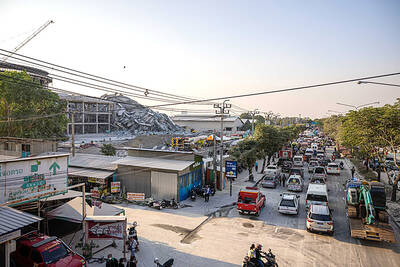India’s airlines are caught in a “perfect storm” of big losses, high debt and falling demand, and need urgent help from the new government to make them high-flyers again, an industry report said.
The struggling sector was once a vibrant symbol of India’s economic progress but it has seen its fortunes nosedive because of over-expansion, costly fuel and cut-throat competition.
“The industry now is at a very critical stage,” said Kapil Kaul, India head of the Sydney-based Center for Asia Pacific Aviation, the consultancy that authored the report entitled Aviation Agenda for The Next Indian Government.
Sector losses for the fiscal year that ended in March are expected to nearly double from last year to US$1.75 billion, Kaul said.
That’s a fifth of the losses of airlines globally of US$8.5 billion estimated by the International Air Transport Association.
“India’s contribution to this [loss] is significantly higher than the 2 percent of world air traffic for which it accounts,” the report said.
The Indian industry’s woes are highlighted by a slump in passengers. Last month, the number of domestic passengers fell by 591,000 or 15.2 percent year-on-year, the fourth straight month of declines.
The figures are a far cry from earlier heady government forecasts that passenger growth would run at 25 percent annually until the end of the decade.
Passenger numbers were expanding by double digits when India’s economy was booming. Cheap fares and increasing affluence among India’s middle classes drove a migration from the country’s antiquated train network to planes.
After the government opened India’s skies to more competition in 2004, a clutch of new airlines took flight, revolutionizing domestic travel in the country of 1.1 billion.
But then costlier oil pushed up air fares last year, sending many passengers back to trains.
Now the sector has also been hit by a slowing economy triggered by the global financial crisis, reducing business and leisure journeys.
“It needs to quickly restructure and the new government has to help them reduce high structural costs,” Kaul said, citing hefty jet fuel taxes.
There is also a need to allow more domestic airlines to fly internationally to boost revenues, Kaul said.
The Congress-led government should allow foreign airlines to take equity stakes in domestic airlines to give them access to fresh capital, he said, but to draw investment the carriers must clean up their balance sheets.
“Over-aggressive expansion” to grab market share was “partly responsible for the fiscal demise of the sector,” the report said.
Flagship state airline Air India is hurting the most. It’s estimated to have racked up US$800 million in losses for the past year and debt of US$4 billion, the report said.
Air India, which flies internationally, merged with government-run domestic carrier Indian last year to become more efficient, but its planes are flying emptier and passenger revenues are still declining.

AIR SUPPORT: The Ministry of National Defense thanked the US for the delivery, adding that it was an indicator of the White House’s commitment to the Taiwan Relations Act Deputy Minister of National Defense Po Horng-huei (柏鴻輝) and Representative to the US Alexander Yui on Friday attended a delivery ceremony for the first of Taiwan’s long-awaited 66 F-16C/D Block 70 jets at a Lockheed Martin Corp factory in Greenville, South Carolina. “We are so proud to be the global home of the F-16 and to support Taiwan’s air defense capabilities,” US Representative William Timmons wrote on X, alongside a photograph of Taiwanese and US officials at the event. The F-16C/D Block 70 jets Taiwan ordered have the same capabilities as aircraft that had been upgraded to F-16Vs. The batch of Lockheed Martin

GRIDLOCK: The National Fire Agency’s Special Search and Rescue team is on standby to travel to the countries to help out with the rescue effort A powerful earthquake rocked Myanmar and neighboring Thailand yesterday, killing at least three people in Bangkok and burying dozens when a high-rise building under construction collapsed. Footage shared on social media from Myanmar’s second-largest city showed widespread destruction, raising fears that many were trapped under the rubble or killed. The magnitude 7.7 earthquake, with an epicenter near Mandalay in Myanmar, struck at midday and was followed by a strong magnitude 6.4 aftershock. The extent of death, injury and destruction — especially in Myanmar, which is embroiled in a civil war and where information is tightly controlled at the best of times —

China's military today said it began joint army, navy and rocket force exercises around Taiwan to "serve as a stern warning and powerful deterrent against Taiwanese independence," calling President William Lai (賴清德) a "parasite." The exercises come after Lai called Beijing a "foreign hostile force" last month. More than 10 Chinese military ships approached close to Taiwan's 24 nautical mile (44.4km) contiguous zone this morning and Taiwan sent its own warships to respond, two senior Taiwanese officials said. Taiwan has not yet detected any live fire by the Chinese military so far, one of the officials said. The drills took place after US Secretary

THUGGISH BEHAVIOR: Encouraging people to report independence supporters is another intimidation tactic that threatens cross-strait peace, the state department said China setting up an online system for reporting “Taiwanese independence” advocates is an “irresponsible and reprehensible” act, a US government spokesperson said on Friday. “China’s call for private individuals to report on alleged ‘persecution or suppression’ by supposed ‘Taiwan independence henchmen and accomplices’ is irresponsible and reprehensible,” an unnamed US Department of State spokesperson told the Central News Agency in an e-mail. The move is part of Beijing’s “intimidation campaign” against Taiwan and its supporters, and is “threatening free speech around the world, destabilizing the Indo-Pacific region, and deliberately eroding the cross-strait status quo,” the spokesperson said. The Chinese Communist Party’s “threats